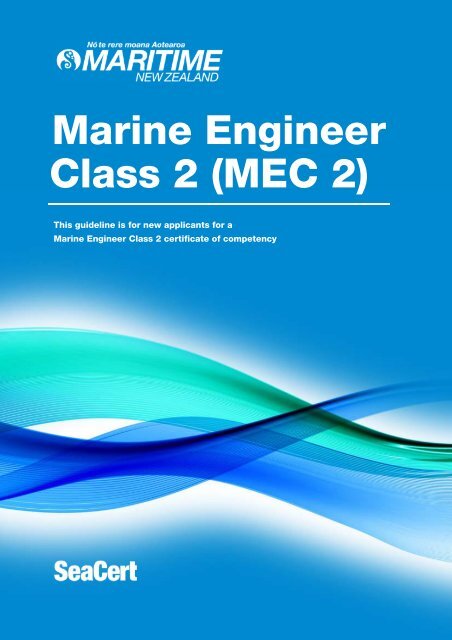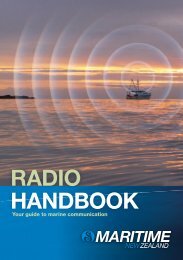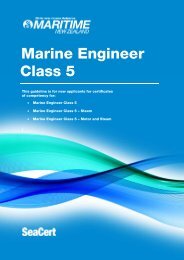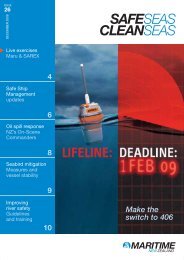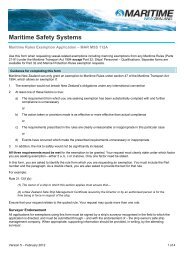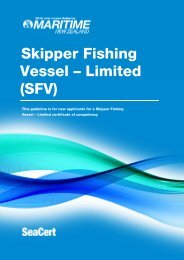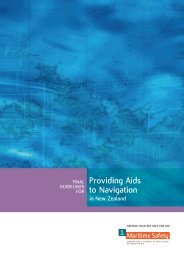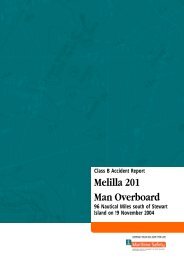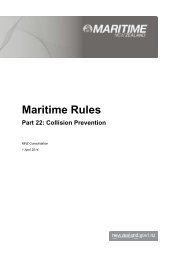Marine engineer MEC2 certificate MNZ guideline - Maritime New ...
Marine engineer MEC2 certificate MNZ guideline - Maritime New ...
Marine engineer MEC2 certificate MNZ guideline - Maritime New ...
Create successful ePaper yourself
Turn your PDF publications into a flip-book with our unique Google optimized e-Paper software.
<strong>Marine</strong> Engineer<br />
Class 2 (MEC 2)<br />
This <strong>guideline</strong> is for new applicants for a<br />
<strong>Marine</strong> Engineer Class 2 <strong>certificate</strong> of competency<br />
<strong>Marine</strong> Engineer Class 2 – Guidance for <strong>certificate</strong> of competency<br />
Page 1 of 20
<strong>Marine</strong> Engineer<br />
Class 2 (MEC 2)<br />
Last updated: 27 May 2014<br />
In this guide<br />
1. Overview 2<br />
2. Requirements 3<br />
2.1 Prior certification and qualifications 3<br />
2.2 Sea service 4<br />
2.3 Training and experience 6<br />
2.4 Fit and proper person 9<br />
2.5 Medical examination and eyesight test 10<br />
2.6 Age and identity 11<br />
3. When and how to apply 12<br />
3.1 Certified copies 12<br />
3.2 Fees and payment options 13<br />
3.3 Application process 14<br />
3.4 Checklist 16<br />
3.5 Where to send your application 18<br />
4. Contact us for help 19<br />
5. Forms 20<br />
<strong>Marine</strong> Engineer Class 2 – Guidance for <strong>certificate</strong> of competency<br />
Page 1 of 20
1. Overview<br />
<strong>Marine</strong> Engineer Class 2 (MEC 2) <strong>certificate</strong> of competency<br />
This <strong>guideline</strong> is for new applicants for the MEC 2 <strong>certificate</strong> of competency. It does not<br />
cover recognition of an equivalent <strong>certificate</strong> obtained outside <strong>New</strong> Zealand.<br />
The information in this <strong>guideline</strong> covers training, sea service and other requirements for the<br />
<strong>certificate</strong>, how to apply and pay for your <strong>certificate</strong>, and where to find out more.<br />
Your MEC 2 <strong>certificate</strong> is valid for five years.<br />
For more details about the requirements for recognition and renewal (revalidation) of<br />
<strong>certificate</strong>s, refer to the <strong>Maritime</strong> <strong>New</strong> Zealand (<strong>MNZ</strong>) website:<br />
maritimenz.govt.nz/seafarers<br />
This <strong>certificate</strong> corresponds with the <strong>certificate</strong> for second <strong>engineer</strong> on ships powered by<br />
main propulsion machinery of 3000kW propulsion power or more, issued under Regulation<br />
III/2 of the International Convention on the Standards of Training, Certification and<br />
Watchkeeping for Seafarers, 1978, as amended in 2010 (STCW).<br />
With a MEC 2 <strong>certificate</strong>, you can perform the functions and duties of:<br />
<br />
<br />
second <strong>engineer</strong> on ships of any main propulsion power in any operating area<br />
chief <strong>engineer</strong> on fishing ships of any propulsion power in any operating area.<br />
The second <strong>engineer</strong> is the <strong>engineer</strong> officer next in rank to the chief <strong>engineer</strong> officer, with<br />
responsibility for the ship’s mechanical propulsion and for the operation and maintenance of<br />
its mechanical and electrical installations in the event of incapacity of the chief <strong>engineer</strong><br />
officer.<br />
For the MEC 2 <strong>certificate</strong>, you can choose to qualify on either motor-powered or steampowered<br />
engines, or on both types of engine. Your sea service and training must be<br />
appropriate for the type of propulsion power, and your <strong>certificate</strong> will show the type of main<br />
engine propulsion power you are qualified to operate on as second <strong>engineer</strong>.<br />
From MEC 2, with additional sea service, training and assessment you can progress to<br />
MEC 2 endorsed chief <strong>engineer</strong> or to MEC 1.<br />
Disclaimer<br />
These <strong>guideline</strong>s provide information and explanations about the requirements set out in the<br />
maritime rules, but are not a substitute for the rules themselves, which are the law. These<br />
<strong>guideline</strong>s refer to provisions in <strong>Maritime</strong> Rules Part 32, Seafarer Certification. The Director of<br />
<strong>Maritime</strong> <strong>New</strong> Zealand (<strong>MNZ</strong>) will grant a <strong>certificate</strong> only when satisfied that all requirements have<br />
been met. In this <strong>guideline</strong>, any references to ‘we’ or <strong>Maritime</strong> <strong>New</strong> Zealand (<strong>MNZ</strong>) relating to a<br />
decision about the issue or renewal of any seafarer <strong>certificate</strong> are references to the Director or a<br />
person acting under the Director’s delegated authority.<br />
maritimenz.govt.nz/rules<br />
<strong>Marine</strong> Engineer Class 2 – Guidance for <strong>certificate</strong> of competency Page 2 of 20
2. Requirements<br />
Before you spend time doing sea service and training, we recommend you check that you<br />
can meet the medical fitness and eyesight standards (including for colour vision), and that<br />
you understand the fit and proper person requirements.<br />
To get this <strong>certificate</strong>, you need to prove that you meet all of the requirements. In summary, you need to:<br />
<br />
<br />
<br />
<br />
<br />
<br />
<br />
be at least 19 years old, medically fit and have good eyesight<br />
be of good character and a fit and proper person<br />
have met the requirements for a MEC 3 <strong>certificate</strong> of competency or equivalent<br />
prove that you have the minimum sea service requirements<br />
attend and pass a MEC 2 training course<br />
obtain <strong>certificate</strong>s for the required ancillary proficiencies<br />
pass <strong>MNZ</strong>’s final exam.<br />
Each of these requirements and how to prove that you meet them is explained below.<br />
You must also have English conversation, reading and writing skills appropriate to the responsibilities and<br />
functions for the level of your <strong>certificate</strong>, so that you can satisfactorily complete training, pass examinations<br />
and discharge your duties.<br />
Note: Some candidates prefer to complete training for the MEC 1 <strong>certificate</strong> without first getting a MEC 2<br />
<strong>certificate</strong>. Once you have completed all of the requirements for your MEC 3 <strong>certificate</strong>, you can progress<br />
to MEC 1 by undertaking additional sea service, training and exams. Refer to the MEC 1 <strong>certificate</strong><br />
<strong>guideline</strong>s for more information.<br />
2.1 Prior certification and qualifications<br />
You must hold a current MEC 3 <strong>certificate</strong> of competency or equivalent.<br />
<strong>Marine</strong> Engineer Class 2 – Guidance for <strong>certificate</strong> of competency<br />
Page 3 of 20
2. Requirements (continued)<br />
2.2 Sea service<br />
Sea service requirements<br />
Your sea service must be relevant and appropriate to the requirements set out in the maritime rules. In<br />
practice, this means that you should:<br />
<br />
<br />
complete all of your sea service as an <strong>engineer</strong>ing officer (exercising the role of MEC 3) in the<br />
engine department, while holding your MEC 3 or equivalent <strong>certificate</strong> and<br />
complete at least 12 months’ approved sea service performing engine room watchkeeping duties<br />
on commercial ships or <strong>New</strong> Zealand warships with propulsion power of 750kW or more.<br />
You must also complete one of the following options:<br />
Option 1 (certifying motor propulsion): at least six months’ sea service on a motor ship (a ship with<br />
diesel main propelling machinery) with propulsion power of 750kW or more<br />
Option 2 (certifying steam propulsion): at least six months’ sea service on a steam ship with<br />
propulsion power of 750kW or more<br />
Option 3 (certifying combined motor and steam propulsion): at least six months’ sea service on motor<br />
ships with propulsion power of 750kW or more, and at least six months on steam ships with<br />
propulsion power of 750kW or more.<br />
All of your sea service must have been completed in the 10 years before your <strong>certificate</strong> is issued.<br />
Proving your sea service<br />
You are responsible for ensuring that your sea service is documented and verified by your ship’s master or<br />
company. The summary of sea service form on <strong>MNZ</strong>’s website can be used to help keep track of your sea<br />
service. (This form is not required for your <strong>certificate</strong> application.)<br />
To support your sea service, you must provide at least one of the following documents for each vessel you<br />
have served on:<br />
<br />
<br />
<br />
<strong>certificate</strong> of sea service<br />
completed seafarer’s record book<br />
discharge <strong>certificate</strong> or discharge book (if using a <strong>New</strong> Zealand discharge book, make sure you<br />
get the watchkeeping section signed off).<br />
If it is not included in any of the documents above, you must also provide a reference (on company<br />
letterhead), from the ship’s master, chief <strong>engineer</strong> or your employer. The reference must state the start and<br />
end dates of your service, your duties while in service, and your experience, conduct, sobriety and ability.<br />
Each of the documents you provide for each vessel must contain:<br />
<br />
<br />
<br />
<br />
<br />
your employer’s name and contact details<br />
the name, tonnage details and type of vessel (for example, passenger, non-passenger, fishing)<br />
the type of cargo carried and area of operation<br />
the dates you were employed and the sea time you completed<br />
your duties and the actual time spent on engine room watchkeeping.<br />
Any statutory declarations you have made are not acceptable as proof of your sea service.<br />
<strong>Marine</strong> Engineer Class 2 – Guidance for <strong>certificate</strong> of competency Page 4 of 20
2. Requirements (continued)<br />
Calculating sea service<br />
Relevant qualifying sea service is expected to be on voyages of 24 hours or more, calculated as follows:<br />
<br />
<br />
<br />
from the sign-on date of starting work on the ship to the sign-off date of discharge (both dates are<br />
inclusive)<br />
by counting each whole calendar month during this period as one month<br />
for multiple voyages, by adding together extra days that do not fall within a calendar month, with<br />
each addition of 30 days to be calculated as one month.<br />
Extended time in port is generally not counted as sea service, and nor is time on leave.<br />
Note:<br />
Voyage means a voyage between a port or place of departure and a ship’s final port or place of<br />
arrival. It includes any period of 24 hours (or more) where you are signed on or employed on the<br />
vessel and you remain on board.<br />
For example: If your service record shows your sign-on date as 3 March and sign-off date as 14<br />
April, your sea service would be calculated as one month (3 March to 2 April) and 12 days (from 3<br />
to 14 April inclusive).<br />
Sea service pre-assessment<br />
If you are unsure whether you have met the sea service requirements, you can ask us to assess your sea<br />
service time before you make your full application. We charge a fee to do this (see 3.2 Fees and payment<br />
options).<br />
To have your sea service pre-assessed, you need to:<br />
<br />
<br />
<br />
apply for pre-assessment using <strong>MNZ</strong>’s pre-assessment form<br />
pay a pre-assessment fee<br />
send us the documents we need (see Proving your sea service above) in order to check your sea<br />
service.<br />
Note:<br />
If you are pre-assessed and have the required sea service for the MEC 2 <strong>certificate</strong>, add your preassessment<br />
reference number to your seafarer <strong>certificate</strong> application form.<br />
<strong>Marine</strong> Engineer Class 2 – Guidance for <strong>certificate</strong> of competency<br />
Page 5 of 20
2. Requirements (continued)<br />
2.3 Training and experience<br />
Training<br />
You must attend and pass an approved MEC 2 training course to achieve all of the required competencies<br />
at the management level, as specified in section A-III/2 of the STCW Code.<br />
The <strong>New</strong> Zealand <strong>Maritime</strong> School offers options for completing MEC 2 and MEC 1 training separately or<br />
together.<br />
Check with your training provider about which papers you must pass to fulfill the training requirements for<br />
the MEC 2 <strong>certificate</strong>.<br />
You can find out more about training providers and the competency framework for this <strong>certificate</strong> on<br />
<strong>MNZ</strong>’s website:<br />
maritimenz.govt.nz/seafarers<br />
Final examination<br />
You must pass a final examination (currently an oral examination) by an <strong>MNZ</strong>-approved examiner. This is<br />
usually arranged by your training provider. Your results will be sent to <strong>MNZ</strong>.<br />
Refer to the <strong>MNZ</strong> website for more information:<br />
maritimenz.govt.nz/seafarers<br />
<strong>Marine</strong> Engineer Class 2 – Guidance for <strong>certificate</strong> of competency Page 6 of 20
2. Requirements (continued)<br />
Ancillary <strong>certificate</strong>s<br />
You must provide current copies of the ancillary <strong>certificate</strong>s you gained as part of your MEC 3 training.<br />
These are shown below. Your training provider should also offer this training and will provide you with a<br />
<strong>certificate</strong> for each of these courses to confirm that you have demonstrated proficiency in the required<br />
skills.<br />
If you already have a current ancillary <strong>certificate</strong> that demonstrates proficiency in the areas listed below and<br />
at the required level, you may use it – as long as the specific requirements are met.<br />
Ancillary <strong>certificate</strong> requirements<br />
STCW basic training<br />
Proficiency in survival craft and rescue boats<br />
other than fast rescue boats (PISC)<br />
Advanced fire fighting<br />
Proficiency in medical first aid<br />
Document(s) you must provide<br />
STCW basic training that complies with STCW<br />
A-VI/1 paragraph 2 and covers basic personal<br />
survival techniques (A-VI/1–1), fire prevention<br />
and fire fighting (A-VI/1–2), elementary first aid<br />
(A-VI/1–3) and personal safety and social<br />
responsibility (A-VI/1–4). This may be issued as<br />
one <strong>certificate</strong> citing the four elements or as four<br />
separate <strong>certificate</strong>s<br />
STCW survival craft and rescue boats other than<br />
fast rescue boats <strong>certificate</strong> that complies with<br />
STCW Code section A-VI/2 paragraphs 1–4<br />
(Table A-VI/2-1)<br />
STCW advanced fire fighting <strong>certificate</strong> that<br />
complies with STCW Code section A-VI–3,<br />
paragraphs 1–4 (Table A-VI/3)<br />
STCW medical first aid on board ship <strong>certificate</strong><br />
that complies with STCW Code section A-VI/4,<br />
paragraphs 1–3 (Table A-VI/4-1)<br />
Your ancillary <strong>certificate</strong>s must:<br />
<br />
be current (not expired) when we issue your MEC 2 <strong>certificate</strong><br />
Note: The following ancillary certifications must be less than five years old from the date of issue (or,<br />
if older, you must demonstrate that you have maintained the required standard of competency to<br />
undertake the tasks, duties and responsibilities specified in the relevant STCW tables):<br />
o<br />
o<br />
o<br />
o<br />
STCW A-VI/1-1 basic personal survival techniques<br />
STCW A-VI/1-2 fire prevention and fire fighting<br />
STCW A-VI/2-1 proficiency in survival craft and rescue boats other than fast rescue boats<br />
(PISC)<br />
STCW A-VI/3 advanced fire fighting (section 3.6 and Table A-VI/3).<br />
<strong>Marine</strong> Engineer Class 2 – Guidance for <strong>certificate</strong> of competency<br />
Page 7 of 20
2. Requirements (continued)<br />
Your <strong>certificate</strong>s must also:<br />
<br />
<br />
<br />
conform to the STCW regulations and have the appropriate STCW regulation number<br />
be from a training provider approved under the <strong>New</strong> Zealand Education Act or by <strong>Maritime</strong> <strong>New</strong><br />
Zealand, or from a training provider in a country where <strong>MNZ</strong> has determined that ancillary training<br />
is STCW-compliant. (Refer to the recognition <strong>guideline</strong>s on <strong>MNZ</strong>’s website for information about<br />
recognition of ancillary <strong>certificate</strong>s obtained outside <strong>New</strong> Zealand)<br />
be seen by us before we can issue your MEC 2 <strong>certificate</strong>.<br />
Although it is not an STCW requirement, we encourage you to maintain the currency of your <strong>certificate</strong>s for<br />
first aid and medical first aid on board ship, in accordance with the requirements of the issuing<br />
organisation.<br />
For more details, including the information you need to provide to demonstrate currency if you already hold<br />
an ancillary <strong>certificate</strong>, refer to the ancillary <strong>certificate</strong> <strong>guideline</strong>s on <strong>MNZ</strong>’s website:<br />
maritimenz.govt.nz/seafarers<br />
Security awareness training<br />
<strong>MNZ</strong> strongly recommends that you also get an ancillary <strong>certificate</strong> for proficiency in security awareness<br />
training (STCW A-VI/6-1). This <strong>certificate</strong> is needed if you wish to work on any ship that the International<br />
Ship and Port Facility Security (ISPS) Code applies to.<br />
If you do not provide this ancillary <strong>certificate</strong>, your MEC 2 <strong>certificate</strong> will have a condition stating that<br />
without a current <strong>certificate</strong> for proficiency in security awareness training (STCW A-VI/6-1), it is not valid for<br />
vessels to which ISPS applies.<br />
We will accept a proficiency in security awareness training <strong>certificate</strong> that has been approved by the<br />
administration of any country with which <strong>New</strong> Zealand has an agreement for recognition of STCW<br />
<strong>certificate</strong>s.<br />
For more information about ancillary security awareness training or the recognition process for this<br />
<strong>certificate</strong>, refer to the ancillary <strong>guideline</strong>s or recognition <strong>guideline</strong>s, respectively, on <strong>MNZ</strong>’s website:<br />
maritimenz.govt.nz/seafarers<br />
<strong>Marine</strong> Engineer Class 2 – Guidance for <strong>certificate</strong> of competency Page 8 of 20
2. Requirements (continued)<br />
2.4 Fit and proper person<br />
We need to confirm that you are of good character. To help us do this, there are several<br />
forms we need from you, which are outlined below.<br />
Requirement<br />
Document(s) you must provide<br />
Be of good character A character reference describing what you are like<br />
as a person. It must:<br />
o<br />
o<br />
o<br />
be signed and dated<br />
refer to the last 12 months<br />
not be from a family member<br />
<br />
<br />
<br />
A completed fit and proper person form, which you<br />
must have signed and dated no more than three<br />
months before we receive your application<br />
A completed consent to disclosure of information<br />
form so that the <strong>New</strong> Zealand Police can check<br />
your record. You must have signed and dated this<br />
form no more than three months before we receive<br />
your application<br />
A police clearance report for any country or<br />
countries outside <strong>New</strong> Zealand that you have lived<br />
in for 12 months or longer in the past five years<br />
(covering the entire period you lived in that country<br />
or countries)<br />
Refer to 5. Forms for all of the forms that you will need to complete your application.<br />
Links related to this requirement<br />
→ Apply for or renew a passport [Internal Affairs website]<br />
→ Get your driver’s licence [NZ Transport Agency website]<br />
→ Apply for your birth <strong>certificate</strong> [Internal Affairs website]<br />
<strong>Marine</strong> Engineer Class 2 – Guidance for <strong>certificate</strong> of competency<br />
Page 9 of 20
2. Requirements (continued)<br />
2.5 Medical examination and eyesight test<br />
You need to prove that your medical fitness and eyesight meet the required standard.<br />
Requirement<br />
Be medically fit<br />
Document(s) you must provide<br />
A <strong>certificate</strong> of medical fitness for seafarers that is valid at the time we issue<br />
your MEC 2 <strong>certificate</strong> (after you have completed all of your exams and ancillary<br />
<strong>certificate</strong>s).<br />
This is a special medical <strong>certificate</strong> that complies with STCW regulation I/9.<br />
You must get this from an approved medical practitioner, or from a medical<br />
practitioner approved for issuing seafarer medicals in another country that is<br />
party to STCW.<br />
You may use an existing medical <strong>certificate</strong> if it will be valid (usually less than<br />
two years old) when your MEC 2 <strong>certificate</strong> is issued.<br />
<br />
Your medical practitioner will send us a copy or we will accept a certified<br />
copy.<br />
Have good eyesight<br />
Eyesight test results showing you have met the required standards for:<br />
<br />
<br />
visual acuity (including a letter eyesight test). Your eyesight test results must<br />
be less than 12 months old at the time we issue your <strong>certificate</strong><br />
colour vision. This is initially assessed as part of the seafarer’s <strong>certificate</strong> of<br />
medical fitness, using the Ishihara colour vision test. If you fail the Ishihara<br />
test, you will need to take an alternative colour vision test with a registered<br />
optometrist (for more details, refer to the Advisory Circular for Part 34 on<br />
<strong>MNZ</strong>’s website).<br />
Your colour vision test results (of either test) must be less than six years old<br />
at the time your MEC 2 <strong>certificate</strong> is issued.<br />
Your medical practitioner (or optometrist, if required) will send us the results of<br />
your eye tests.<br />
For more information about the medical and eyesight requirements for this <strong>certificate</strong>, refer to the<br />
<strong>guideline</strong>s on <strong>MNZ</strong>’s website:<br />
maritimenz.govt.nz/seafarers<br />
<strong>Marine</strong> Engineer Class 2 – Guidance for <strong>certificate</strong> of competency Page 10 of 20
2. Requirements (continued)<br />
2.6 Age and identity<br />
We need to confirm your age and identity. To help us do this, there are several documents<br />
we need from you, which are outlined below.<br />
Requirement<br />
Prove your identity and be 19 or older<br />
Document(s) you must provide<br />
Your completed seafarer <strong>certificate</strong> application<br />
form (remember to sign where indicated)<br />
<br />
<br />
Either your passport (make sure it has not<br />
expired) or your driver’s licence and birth<br />
<strong>certificate</strong><br />
Four passport-sized photographs (or ask the<br />
photographer to provide an electronic copy,<br />
which you can then forward to <strong>MNZ</strong> if you are<br />
emailing us your application)<br />
Refer to 5. Forms for all of the forms that you will need to complete your application.<br />
Links for these requirements<br />
→ Apply for or renew a passport [Internal Affairs website]<br />
→ Get your driver’s licence [NZ Transport Agency website]<br />
→ Apply for your birth <strong>certificate</strong> [Internal Affairs website]<br />
<strong>Marine</strong> Engineer Class 2 – Guidance for <strong>certificate</strong> of competency<br />
Page 11 of 20
3. When and how to apply<br />
Apply when you have completed all of the <strong>certificate</strong> requirements. Once we have received<br />
all of the information we need from you, it may take us up to 20 working days to process<br />
your application, so send it in as soon as possible (and at least one month before you need<br />
your <strong>certificate</strong>).<br />
Make sure you include all of the documents we have asked for. Refer to 3.4 Checklist to make sure you<br />
have everything you need for your application. (If you have made a mistake or left out something we have<br />
asked for, your application is likely to be delayed.)<br />
3.1 Certified copies<br />
We need certified copies of your supporting documents, not the original versions.<br />
A certified copy is a photocopy that has been certified as being a true and accurate copy. Certified copies<br />
must clearly show the certifier’s name and title beneath their signature. Any additional pages must show<br />
the initials of the person certifying the document.<br />
Your documents can be certified by:<br />
<br />
<br />
<br />
<br />
a justice of the peace<br />
a notary public<br />
a barrister or solicitor of the High Court of <strong>New</strong> Zealand<br />
your training provider.<br />
You can get contact details for your local certifiers from the Citizens Advice Bureau or Yellow Pages.<br />
We do not need to see any of the documents you have already sent to us for other applications – just<br />
make a note about these documents in your application. However, if any of these documents has expired<br />
or will expire before we issue your <strong>certificate</strong>, we need to see a certified copy of the new or renewed<br />
document.<br />
<strong>Marine</strong> Engineer Class 2 – Guidance for <strong>certificate</strong> of competency Page 12 of 20
3. When and how to apply (continued)<br />
3.2 Fees and payment options<br />
The fee for this <strong>certificate</strong> is NZ$761, which includes goods and services tax (GST).<br />
If applicable, the sea service pre-assessment fee is NZ$304, including GST. If your sea service is preassessed,<br />
your MEC 2 application fee will be reduced to NZ$625, including GST.<br />
You need to include payment by cheque or indicate your other chosen payment method on your seafarer<br />
<strong>certificate</strong> application form.<br />
You can pay:<br />
<br />
<br />
<br />
online using a credit card or debit card, or<br />
by internet banking or bank deposit, or<br />
by cheque (which you include with your application).<br />
Note: If you are not paying by cheque, we will give you the payment reference details when we receive<br />
your application. We do not want you to send us your credit card details.<br />
Refer to the <strong>MNZ</strong> website for more information about how to pay your fees:<br />
maritimenz.govt.nz/howtopay<br />
As well as the application fee, you may have other fees and expenses to pay. For example, you may need<br />
to pay for your eyesight tests and medical examination, your training and ancillary courses, and to make<br />
copies of your documents and have them certified.<br />
<strong>Marine</strong> Engineer Class 2 – Guidance for <strong>certificate</strong> of competency<br />
Page 13 of 20
3. When and how to apply (continued)<br />
3.3 Application process<br />
This is the application process for this <strong>certificate</strong> of competency. Complete each step before<br />
you move on to the next one.<br />
1<br />
Do you meet all of the requirements?<br />
Check that you meet all of the requirements for this <strong>certificate</strong>.<br />
Move to step 2 once you know what the requirements are and that you can meet them.<br />
2<br />
Do you have the documents we need?<br />
Prove that you meet the requirements. Include all of the documents we have<br />
asked for. Use the checklist (see 3.4. Checklist) to help you.<br />
Remember: we need certified copies, not the originals.<br />
Move to step 3 once you have certified copies of all of the documents we have asked for.<br />
3<br />
Complete the application forms<br />
You need to complete several forms as part of your application. Use the checklist<br />
to help make sure you have provided all of the information we need.<br />
Move to step 4 once you have completed all of the forms needed for your application.<br />
4<br />
Pay the application fee<br />
You need to pay an application fee. The options for payment are:<br />
<br />
<br />
<br />
<br />
pay by bank deposit or internet banking, or<br />
pay online using a credit card or debit card, or<br />
include a cheque with your application.<br />
Move to step 5 once you know what you need to pay and you have either included a<br />
cheque with your application or chosen another payment option.<br />
<strong>Marine</strong> Engineer Class 2 – Guidance for <strong>certificate</strong> of competency Page 14 of 20
3. When and how to apply (continued)<br />
5<br />
Send us your application by courier or email<br />
There are two options for you to send your application:<br />
1. Use a courier to send us your completed forms, certified documents and<br />
cheque for the application fee (if using that payment option).<br />
2. Send your application by email, attaching the scanned documents. (The<br />
application form has information about the requirements for electronic<br />
copies.)<br />
Move to step 6 once you have ticked everything on the checklist and either couriered or<br />
emailed your completed application to <strong>MNZ</strong> (using the address provided at 3.5 Where to<br />
send your application).<br />
6<br />
Send confirmation and/or request<br />
We will send you an email or letter to:<br />
<br />
<br />
<br />
confirm that we have received your application<br />
give you reference details to pay the application fee (if you did not include a cheque<br />
with your application)<br />
list any documents we need from you before we can assess your application.<br />
We must receive your payment before we can progress your application.<br />
7<br />
Assessment<br />
After you have paid the fee and sent us all the documents we need, we will<br />
assess your application and make a decision. This will usually take 20 working<br />
days (about a month).<br />
8<br />
Issue <strong>certificate</strong><br />
We will send you:<br />
1. your <strong>certificate</strong>, if your application has been successful, or<br />
2. an email or letter explaining why your application was unsuccessful.<br />
<strong>Marine</strong> Engineer Class 2 – Guidance for <strong>certificate</strong> of competency<br />
Page 15 of 20
3. When and how to apply (continued)<br />
3.4 Checklist<br />
Use this checklist to make sure you have everything you need for your application.<br />
Check that your documents are complete and have been signed, dated and certified as required.<br />
We need to see all of the documents listed below to confirm that you have met each requirement. The only<br />
exceptions to this are documents that you have already sent to us for other applications (just note this in<br />
your application). However, if a document has expired or will expire before we issue your <strong>certificate</strong>, we<br />
need to see a certified copy of the new or renewed document.<br />
About you<br />
Seafarer <strong>certificate</strong> application form (remember to sign the form)<br />
Passport or driver’s licence and birth <strong>certificate</strong><br />
Four passport-sized photos or an electronic copy<br />
Character reference<br />
Fit and proper person form<br />
Consent to disclosure of information form<br />
Police clearance for other countries (if applicable)<br />
Certificate of medical fitness for seafarers<br />
If applicable, eyesight test(s) results from an optometrist<br />
Your pre-assessment reference number if we pre-assessed your sea service<br />
Your MEC 2 training<br />
Course completion letter and assessment record<br />
Your final examination results<br />
<strong>Marine</strong> Engineer Class 2 – Guidance for <strong>certificate</strong> of competency Page 16 of 20
3. When and how to apply (continued)<br />
Your sea service<br />
Include at least one of the following for each vessel/period of sea service:<br />
Certificate of sea service<br />
Discharge book (or discharge <strong>certificate</strong>s)<br />
Seafarer’s record book showing your seagoing service<br />
Include the following for all of your sea service:<br />
Summary of sea service form<br />
Master’s and/or employer’s reference (testimonial) on company letterhead (unless included in<br />
evidence of sea service above)<br />
Your ancillary <strong>certificate</strong>s<br />
STCW A-VI/1 basic training<br />
STCW A-VI/2-1 proficiency in survival craft and rescue boats (other than fast rescue boats)<br />
STCW A-VI/3 advanced fire fighting<br />
STCW A-VI/4-1 medical first aid<br />
STCW A-VI/6-1 security awareness training (if completed)<br />
Remember:<br />
Either include a cheque (in $NZ) or indicate which other payment option you’d like to use<br />
Have your documents certified<br />
Send your application to us by courier or email<br />
Send your application to us as early as you can<br />
Check that your <strong>MNZ</strong>-approved <strong>Maritime</strong> Examiner has sent us your final exam results<br />
If required, check that your optometrist has sent us your eyesight test results<br />
<strong>Marine</strong> Engineer Class 2 – Guidance for <strong>certificate</strong> of competency<br />
Page 17 of 20
3. When and how to apply (continued)<br />
3.5 Where to send your application<br />
To provide extra security, we recommend that you courier your application forms and<br />
documents to us.<br />
Alternatively, you can scan and email your application and supporting documents (refer to<br />
the application form for information about how to send your documents electronically).<br />
Courier your application to:<br />
Seafarer Certification<br />
<strong>Maritime</strong> <strong>New</strong> Zealand<br />
1 Grey Street<br />
WELLINGTON 6011<br />
Or<br />
Email your application to:<br />
seafarers@maritimenz.govt.nz<br />
<strong>Marine</strong> Engineer Class 2 – Guidance for <strong>certificate</strong> of competency Page 18 of 20
4. Contact us for help<br />
If you need more information about the requirements for your application, visit the Seafarer<br />
Certification section of our website.<br />
maritimenz.govt.nz/seafarers<br />
If you can’t find the information you need, send us an email:<br />
seafarers@maritimenz.govt.nz<br />
Tell us what you need help with and remember to include your contact details (email address and phone<br />
numbers).<br />
We need your completed application before we can assess whether you meet the requirements for this<br />
<strong>certificate</strong> of competency. However, you may apply for pre-assessment of your sea service (refer to<br />
2.3 Training and experience).<br />
<strong>Marine</strong> Engineer Class 2 – Guidance for <strong>certificate</strong> of competency<br />
Page 19 of 20
5. Forms<br />
To apply for a maritime <strong>certificate</strong> of competency, there are several forms that you must<br />
provide and some that you may provide, depending on your situation.<br />
Everyone applying for this <strong>certificate</strong> of competency must complete and send us all of the following forms:<br />
Seafarer <strong>certificate</strong> application form<br />
Fit and proper person form<br />
Consent to disclosure of information form.<br />
Other forms you may need to use:<br />
Summary of seagoing service form<br />
Seafarer <strong>certificate</strong> pre-assessment form<br />
Each of these forms is available on the <strong>MNZ</strong> website:<br />
maritimenz.govt.nz/seafarers<br />
Note:<br />
You must complete these forms correctly for your application to be valid. Carefully read any notes<br />
before you start.<br />
<strong>Marine</strong> Engineer Class 2 – Guidance for <strong>certificate</strong> of competency Page 20 of 20


